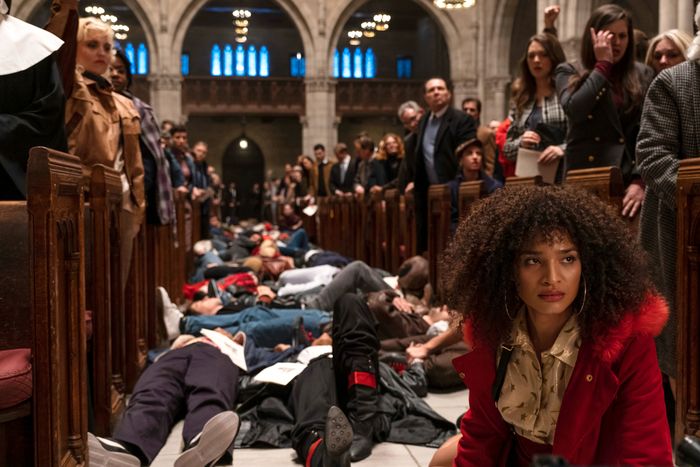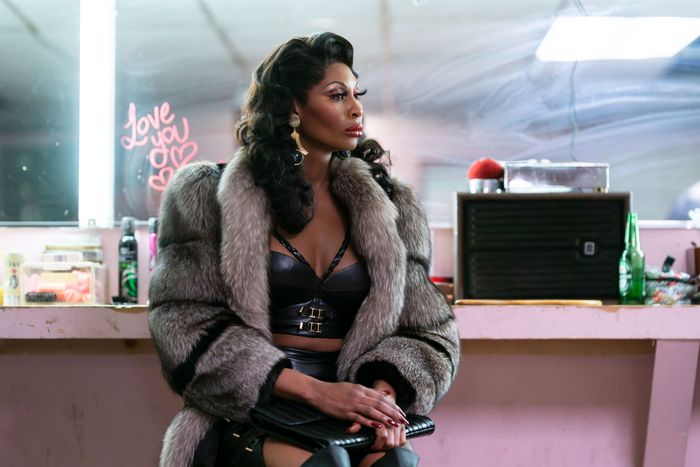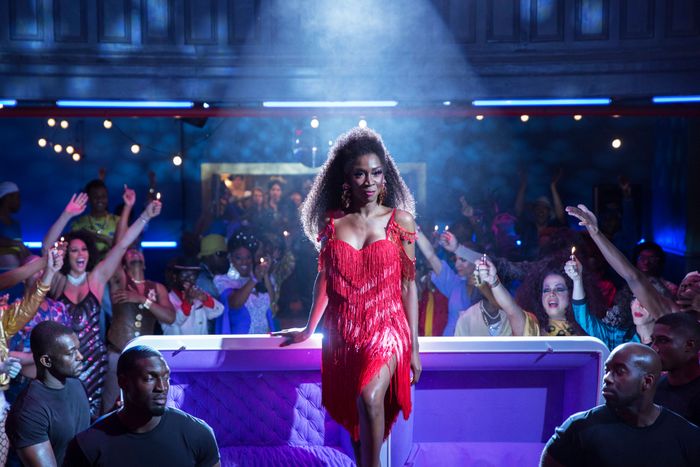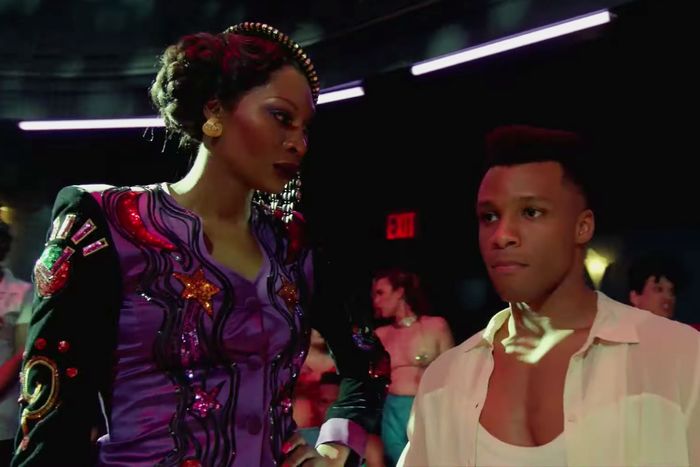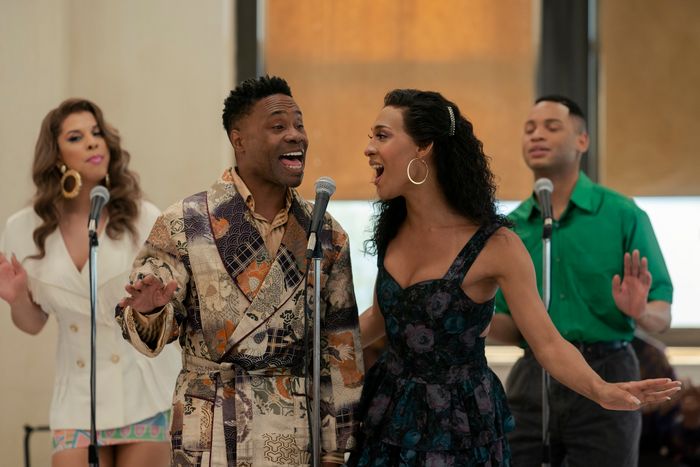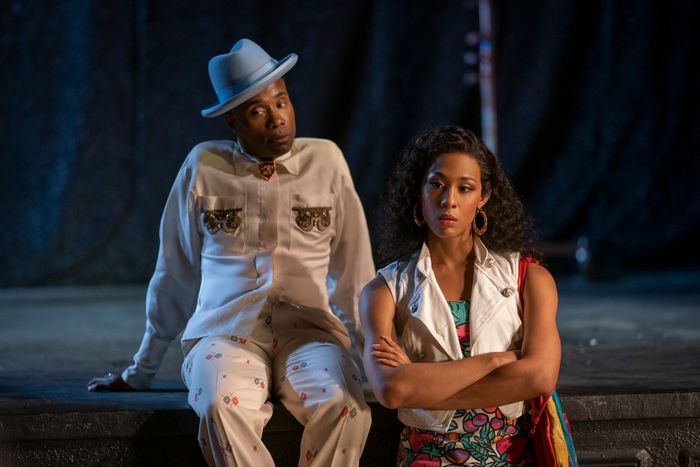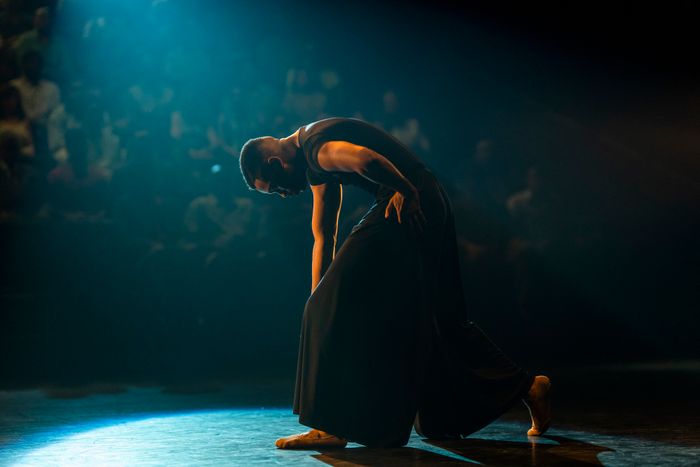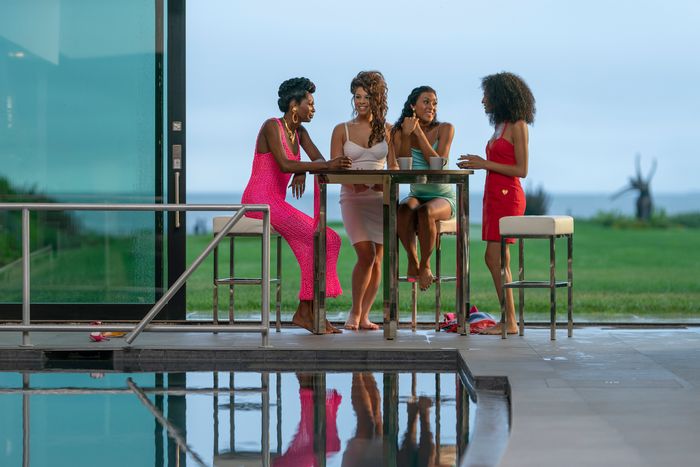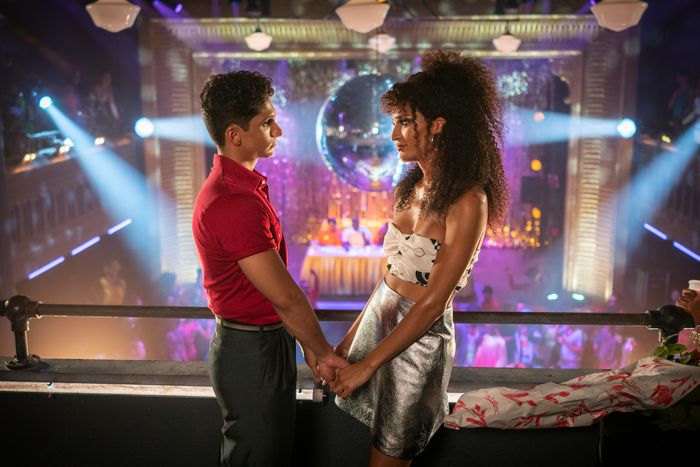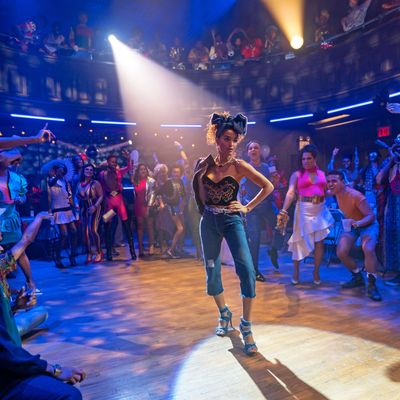
With a Ryan Murphy–size budget and a certified-authentic ballroom imprimatur, Pose packs in more culture per episode than most shows do in a season. And while meticulously crafted series like Stranger Things and GLOW act as nostalgic monuments to their eras, Pose is a living history; a celebration of the music and fashion that defined life in ballroom, which, in turn, reverberated (and still reverberates) throughout the larger cultural consciousness.
To help understand the historical significance of the show’s set pieces, social mores, and lewks, we’re breaking down some of the key cultural references of every episode of season two, with some suggestions for further reading on everything from Coming to America to the history of poppers. Here’s where you can catch up on the music, movies, and history that make up the rich history of NYC’s ballroom scene in 1990.
Episode One: “Acting Up”
Season two begins with a time jump to 1990 and frames the release of Madonna’s “Vogue” as a similar moment of reckoning to what today’s queer underground, and indeed the cast of Pose, is facing: When the larger culture sniffs blood, is it possible to cash in without selling out? As Blanca predicts, “Vogue” put ballroom on the map, with legends Jose and Luis Xtravaganza joining Madonna onstage for her legendary September 1990 VMAs performance.
“Acting Up” is largely concerned with the ballroom community’s response to the AIDS crisis, and re-creates ACT UP’s 1989 die-in at St. Patrick’s Cathedral. For a deeper understanding of ACT UP’s work, the 2012 documentary How to Survive a Plague (available for digital purchase/rental) offers a comprehensive, harrowing chronicle of AIDS activism in NYC, detailing how the movement pummeled the pharmaceutical industry and media to start researching effective treatments.
And for a glimpse of how commerce, mainstream pop culture, and the queer black underground converged in the age of AIDS, watch Susanne Bartsch: On Top (available on Netflix). Revered as the grand sphinx of NYC nightlife and the Club Kid milieu, Bartsch became a key culture warrior in the battle against AIDS. The documentary recounts the 1989 Love Ball, which raised over $2.5 million for HIV/AIDS charities, attracted guests like Madonna, and featured performers from the vogue scene.
Additional text:
1990 saw another coupling of underground NYC culture and mainstream sensibilities in Sandra Bernhard’s 1990 HBO film Without You I’m Nothing. Filmed when Bernhard was at the peak of her provocateur powers, Without You I’m Nothing tears through disco, cabaret, and black culture, with riffs on Burt Bacharach and Diana Ross. Like “Vogue,” Without You I’m Nothing may read as problematic in 2019, but it’s nonetheless another striking example from the era of a highbrow production by a white woman that takes root in underground black culture. Bernhard starts as a full cast member with this episode of Pose; she’s back in her kingdom exploring this period of NYC history.
Episode Two: “Worth It”
Though Angel is a rare star, her dream of supermodel immortality was common of the age: Between roughly 1988 and 1992, models were the contemporary equivalent of Instagram influencers. As Christy Turlington, Naomi Campbell, Linda Evangelista, Cindy Crawford, and other cover girls became full-fledged institutions, millions of women sought to break out at competitions like The Look of the Year.
The documentary Casablancas: The Man Who Loved Women (available on Netflix) chronicles the feverish boom of the era. John Casablancas founded Elite, the agency that has represented Iman, Cindy Crawford, Stephanie Seymour, Paulina Porizkova, and Linda Evangelista. Though the documentary is narrated from a typically chauvinistic late-20th-century male gaze, it’s still an excellent first-person account of the “model wars” of the ’80s and supermodel boom of the early ’90s. Skip past the romanticized accounts of womanizing and gambling for fabulously shady footage of legends like Eileen Ford, Janice Dickinson, and Naomi Campbell.
Additional text:
This episode features no fewer than three separate ball scenes, but the high-fashion feather ball near the end of “Worth It” is arguably Pose’s most spectacular costume showcase to date, with references to a different designer on nearly every competitor. Blanca serves Versace; the children of the House of Wintour vogue like angels from the heavenly gates of Margiela; and Elektra gives a shell-shattering Venus that puts ARTPOP-era Lady Gaga to shame. As always, Billy Porter stands out, this time in a gold satin blouse and jumbo zebra fez that evoke the abundant fabrics and wildly embellished designs of Coming to America. The 1988 Eddie Murphy–Arsenio Hall classic was nominated for an Oscar for costume design and still holds up: Designer Deborah Nadoolman Landis’s designs remained so influential that Lupita Nyong’o and Danai Gurira threw a “Wakandans in Zamunda” party during the filming of Black Panther.
Episode Three: “Butterfly/Cocoon”
Leave it to Elektra to play Janet Jackson’s “Black Cat” while cock-destroying a wealthy white yuppie. If only he’d paid better attention to the lyrics: I’m tryin’ to tell ya boy / It’s a mistake / You won’t realize / ’Til it’s too late …
“Black Cat” came off Jackson’s massively influential Rhythm Nation 1814, a socially conscious experiment that became the best-selling Stateside album of 1990. Though record executives had pushed for a more personal album that would react to the endless scandals of her family, Jackson envisioned Rhythm Nation 1814 as a utopian vision of musical community. The album addressed substance abuse in the black community, the Stockton playground murders, and other social issues of the late ’80s, though perhaps with less literalism than Pose.
“Black Cat” was Jackson’s first foray into arena rock, and, as you’d expect, she slayed, earning a Grammy nomination that made her the only artist in history with nominations spanning five genres. Her 1990 VMAs performance is yet another showcase of Jackson’s live ferocity.
Additional text:
Elektra’s baking-soda-burial job is inspired by the story of ballroom legend Dorian Corey, who kept a mummified corpse in her closet for at least 15 years. You can read the original New York story “The Drag Queen Had a Mummy in Her Closet” on Google Books (page 50), or the NewNowNext recap here.
As for poppers, Pose may have its moral qualms, but the gay party drug is having a resurgence, with the advent of artisanal poppers like Double Scorpio. You can read about the contemporary video-cleaner renaissance as told by Mel Magazine.
Episode Four: “Never Knew Love Like This Before”
Even in 2019, “Never Knew Love Like This Before” is one of the only scripted depictions of an all-too-common tragedy: the death of a black trans woman. Human Rights Coalition reports that at least 11 black trans women have been murdered in the U.S. in 2019 alone, yet their stories rarely make it to the small or big screen.
Candy’s murder evokes the death of Venus Xtravaganza, who was found strangled under a hotel bed on Christmas Day 1988. She was 23 years old. Xtravaganza’s joie de vivre is captured in Jenny Livingston’s essential documentary Paris Is Burning (available on Netflix), with reads like “touch all this skin!” made immortal onscreen. No matter how many times you’ve rewatched Paris Is Burning, which functions in many ways as Pose’s Ur-text, the sudden mention of her death at the end of the movie is a devastating gut punch.
For more of the straight-up, hypertechnical vogue dancing from the opening ball, watch the documentary Kiki. The 2017 feature, set in NYC, effectively follows up on Paris Is Burning with looks at the contemporary evolution of the dance form and the community’s response to AIDS and violence.
Additional text:
Ryan Murphy noted the structural influence of Bob Fosse’s 1979 showbiz classic All That Jazz (Amazon), which, though far removed from the world of ballroom, packs the same punches in its high-drama exploration of grief and builds up to a similarly showstopping final fantasy number.
Episode Five: “What Would Candy Do?”
Elektra wasn’t that far off: A spot on the Blond Ambition tour may be worth a little Jeff Gillooly treatment. A spot onstage with Madonna at her apex meant immortality. The 1990 tour definitively changed the pop star’s legacy and the standards of live performance for her successors — from Lady Gaga to Justin Bieber — forever. Everything that is everything Madonna can be traced down to this cultural convergence: fashion, religion, sex, spectacle, and, of course, controversy.
Talk about culture. The sets were inspired by German Expressionist filmmaker Fritz Lang. Jean-Paul Gaultier designed the looks for this show, including Madonna’s seminal cone-bra (key for her live masturbation performances). The cathedral-inspired set for “Like a Prayer” was the opening shot in an escalating series of provocations involving Catholic imagery, building up to her crucifix performance of “Live to Tell” at her 2006 Confessions tour. Blond Ambition sold tickets like gangbusters, and is the foundation of every live Madonna performance since.
The 1991 documentary Madonna: Truth or Dare (available for digital rental) is a lush chronicle of the tour and just as essential a cultural relic, with concert footage, appearances from favorites of the era like Warren Beatty and Sandra Bernhard, and glimpses of Madonna as an eternal loner finding her place among an adopted family of dancers. The crew, assembled for “Vogue,” included Kevin Stea, Carlton Wilborn, Luis Xtravaganza Camacho, Jose Gutierez Xtravaganza, Gabriel Trupin, Salim Gauwloos, and Oliver S Crume. Their legacy is honored in the 2016 documentary Strike a Pose (Netflix), which recounts the tour and the years that followed from their perspective — including their community’s struggles with AIDS, homelessness, and shifting acceptance from the larger dominant society.
Additional text:
“They’re rebooting Solid Gold!” may be Pose’s most delightful anachronism to date, pegging the terminology of intellectual property resurrection to a time when reboots involved floppy disks and hard drives. Naturally, nobody was about to make a new Solid Gold in 1990, just two years after the original series was cancelled, but it’s Ryan Murphy’s world, and, as it were, Solid Gold is a major antecedent to Glee and Pose.
Essentially the TRL of the ’80s, Solid Gold counted down the top hits of the week, with a crew of… creatively attired dancers serving choreographed interpretations. The series was intermittently hosted by Dionne Warwick (who performs the theme song), and featured co-hosting comedians, among them a young Arsenio Hall and MTV VJ Nina Blackwood.
Though few of the Solid Gold Dancers attained fame after the series, they became a meme for the E-for-effort showbiz ethic — the idea that with some lycra and a few dance moves, you can make a show happen. It’s a touchstone of the scrappy season one aesthetic of Glee.
Though the final appearance of the Solid Gold Dancers is in Bill Murray’s Scrooged, there’s plenty of extant content from the series on Youtube, including performances by Madonna, Tina Turner and a duet between Warwick and Whitney Houston.
Episode Six: “Love’s in Need of Love Today”
Leave it to Candy to name-drop the guest list in Heaven, with everyone from Studio 54 head honcho Steve Rubell to ubiquitous fashion designer Perry Ellis in attendance. Indeed, by 1990, a generation of culture-redefining artists had been lost to AIDS, many of whose stories are still being rediscovered.
It’s still astounding to imagine that Liberace, often unfairly derided as a meme of Las Vegas tackiness, enjoyed long stretches as the world’s highest-paid performer, and attracted screaming crowds (largely of straight women) to see him perform for over four decades. His divine — and disturbing — life is recounted in Steven Soderbergh’s claustrophobic 2013 HBO film Behind the Candelabra (available via HBO’s streaming services).
While Candi’s ghost paid visits to Pray Tell, Robert Mapplethorpe’s was stirring controversy all over the country in 1990. Though the photographer and provocateur died in March 1989, his touring retrospective “The Perfect Moment” continued to spark debates and protests all over the country, and led to an unprecedented obscenity trial for Cincinnati’s Contemporary Arts Center in 1990. Unlike many of his peers in the artistic community whose legacies did not survive past the age of AIDS, Mapplethorpe is richly celebrated in 2019. Patti Smith’s seminal memoir Just Kids depicts the boyish Mapplethorpe that few others would ever know; the HBO documentary Mapplethorpe: Look at the Pictures puts the artist’s influences, triumphs, and shortcomings in perspective; and “Implicit Tensions: Mapplethorpe Now” at the Guggenheim (through January 2020) reconciles with his complicated legacy in the world of art.
Alvin Ailey’s work forever changed the standards of visibility, inclusivity, and rigor in the dance landscape, and beyond his still-booming company in NYC, ballets like Revelations and Cry continue to draw audiences around the world. Though Ailey was fearless when it came to crushing racial stigma in the world of dance, he hid much of his queer life from the public, and even asked his doctor to change his cause of death from AIDS-related complications to blood dyscrasia. Jennifer Dunning’s Alvin Ailey: A Life in Dance recounts Ailey’s brilliant career, but the best way to celebrate his legacy is by seeing the touring and NYC-based Alvin Ailey American Dance Theater.
Additional Text:
Would you expect anything less of a Ryan Murphy–produced cabaret episode than Patti LuPone singing Sondheim? Though Chris Colfer performed “I’m Still Here” on Glee in 2014, the Follies ballad will always be the bread and butter of showbiz dames — and Patti is just one of many in a vast pantheon to take on the song. Broadway Box runs down the definitive best performances of the classic, which includes renditions by Elaine Stritch, Carol Burnett, Eartha Kitt, Shirley MacLaine, Shirley Bassey, and many other divas.
Episode Seven: “Blow”
The large-scale condom inflation at the center of “Blow” is too ridiculous for fiction. Indeed, in 1991, the offshoot ACT UP group TAG (Treatment Action Guerrillas, later the Treatment Action Group) actually covered the home of Senator Jesse Helms in Arlington, Virginia, with a massive rubber. Helms had proudly proposed and passed laws that halted CDC intervention in the AIDS crisis, claiming that gay men’s “deliberate, disgusting, revolting conduct is responsible for the disease.” For a delicious account of the condom gambit, check out Peter Staley’s first-person written account and Robert Hilferty’s five-minute documentary, TAG Helms, on Youtube.
The effects of AIDS activism were not only critical in saving lives, but unprecedented in their reach. By strategically targeting the FDA, CDC, and pharmaceutical companies to fast-track drug research and policy, ACT UP and its sister organizations proved that even the most marginalized people could make federal agencies and corporations take responsibility. 2012 saw the release of two excellent documentaries on the era: In addition to the aforementioned How To Survive a Plague, United in Anger: A History of ACT UP (currently available on Amazon Prime) is another worthwhile chronicling of the movement’s development from a ragtag gathering into a large-scale, high-stakes operation.
As for the history of AIDS activism on the west coast, watch the 2011 documentary We Were Here, which collects testimonies from activists and survivors in San Francisco. For a more intimate look at the effects of the virus, watch 1993’s disturbing, devastating Silverlake Life: The View From Here. The documentary compiles the final footage of Tom Joslin and Mark Massi, a West Los Angeles gay couple reconciling with their last months before dying of AIDS. There is no last stand or victory against the oppressor here; just care and kindness between soulmates at the end of their lives.
Additional Text:
It’s easy to laugh off “U Can’t Touch This,” but MC Hammer’s video launched several dance moves into the stratosphere, many of which never left circulation. Though “The Bump,” “The Butterfly,” and “The Hammer Dance” are signature Hammer creations, it’s the “Running Man” that has had the, ahem, longest legs. The beloved, endlessly meme-able move broke out first with Fela Kuti, and then with Janet Jackson’s “Rhythm Nation” before becoming a staple for Hammer, Bobby Brown, Vanilla Ice, and Milli Vanilli.
Episode Eight: “Revelations”
While Patti Lupone’s Frederica Norman made for a delicious villain this season, perhaps Pose missed an opportunity by not following Damon to London to meet the fabulously tactless Malcolm McLaren. Who could have played the infamous British impresario? Eddie Marsan? Steve Coogan? John Lithgow? Born in 1946, McLaren rose to infamy in the ’70s, when he and then-girlfriend Vivienne Westwood opened the shop “Sex” in London. From his throne as a cultural arbiter, he helped launch the Sex Pistols, Bow Wow Wow, and Adam Ant. As the ’90s loomed, he experimented with hip-hop and, eventually, voguing culture, most notably in 1989’s “Deep in Vogue,” which featured ballroom legend Willie Ninja and sampled Pose favorite “Love Is the Message.”
“Deep in Vogue” notably incorporates clips from Paris Is Burning, with footage shared by director Jenny Livingston two years before the film’s initial release. As it predates Madonna’s “Vogue” by nine months, it may be the first case of the the industry sniffing blood in Harlem. For better or worse, McLaren was one of the first white producers to bring hip-hop and world music to the mainstream. But his legacy is marred by a garish lack of responsibility when it came to the art and cultures of others. Where McLaren went, legions of disgruntled artists and performers followed.
Additional Text:
Many TV shows give their best barn-burners the title “Revelations,” from Buffy to Battlestar Galactica. But Pose’s most dramatic chapter yet is named after Alvin Ailey’s signature dance piece, Revelations. Naturally, Damon’s final performance before graduation is “Didn’t My Lord Deliver Daniel,” which comes from the first third of Revelations, “Pilgrim of Sorrow.”
Revelations was inspired by Ailey’s Baptist upbringing in rural Texas. The work is a celebration of gospel, blues, and spirituals, and features numbers like “Wade in the Water” and “Rocka My Soul in the Bosom of Abraham.” It has been performed around the world since 1960.
Episode Nine: “Life’s a Beach”
Every season of Pose must include at least one epic read from Elektra Wintour, née Abundance. At the end of season one, she absolutely dragged her former daughters Lulu and Candy to filth. And this season’s beach outing culminates in a sublime L.L. Bean assassination!
With Drag Race celebrating reading every season, the way of shade is now in abundance, from the annual Haters Roast tour to the podcast and soon-to-be-series The Read, starring Crissle West and Kid Fury. But the art of reading is nearly as old as ballroom. Drag queens and trans members of the community have long used the read as a means of expressing authenticity, asserting their place in the ranks, and proving that they won’t suffer fools. To read your sister is to show her love, and lift her up to the highest standards.
In its documentation of the 1967 Miss All-American Camp Beauty Pageant, The Queen (a restoration of which is now touring cinemas) provides us with some of the first-recorded — and most legendary — reads, courtesy of ballroom arch-diva Crystal LaBeija. And, of course, there’s no better instructor in the ancient language of reading than Dorian Corey (with help from Venus Xtravaganza) in Paris Is Burning (available on Netflix). Nearly all contemporary drag slang comes down to the work of these foremothers.
There may be no better inductee to the art of reading than Terence Stamp, who plays the bone-dry, subtly savage Bernadette in The Adventures of Priscilla, Queen of the Desert (available for digital rental via Amazon), still the greatest drag movie of all time. Few openers can beat “Listen here, you mullet.” And though the recent Broadway adaptation honored Priscilla’s Oscar-winning costume design, it couldn’t quite translate the stone-cold art of reading to Giuliani’s family-friendly Great White Way.
Additional Text:
“O.J. himself would approve” of Elektra’s rental whip, indeed. Simpson was Hertz’s star spokesperson from 1975 until his arrest for the murder of his wife, Nicole Brown Simpson, in 1994. In the story “The Run of His Life,” Ad Age notes that Simpson’s superheroic, fabulously cheesy commercials helped put the rental company on the map — with a 50 percent surge in net profits in his first year. The popular series of commercials — 13 in total — featured O.J. running through airports, while (mostly white) flight attendants and passengers cheered him on. The partnership was so profitable that Hertz kept ties with Simpson even after his first arrest for domestic battery in 1989. Of course, it would all rebound when Simpson made his infamous Bronco getaway.
Episode Ten: “In My Heels”
Angel may be an uncanny star for her era, but as a trans woman in the world of modeling, she’s not unprecedented. British model/actress Caroline “Tula” Cossey had worked prolifically since the ’70s, with spreads in Australian Vogue and Harper’s Bazaar, though in order to keep her career and life safe, Tula’s trans identity was largely kept quiet. In 1981, Cossey appeared as a poolside extra in the 007 vehicle For Your Eyes Only. The brief Bond Girl stint afforded Cossey greater-than-ever exposure, but it came with a cost. After posing for a Playboy spread, Cossey was targeted by the British tabloid News of the World, in a story headlined “James Bond’s Girl Was a Boy.”
Cossey struck back by fully claiming her public trans identity. She wrote two memoirs, I am a Woman and My Story, and appeared for interviews with Arsenio Hall, Howard Stern, and Phil Donahue. After approaching Playboy in 1991, she became the first trans woman in the magazine’s history to appear in her own pictorial.
In 2015, Playboy caught up with Tula, now retired from modeling and living in suburban Atlanta. Though she broke down barriers for trans women in the industry, she had to do it alone, decades before the age of Orange is the New Black, I Am Cailtin, and Pose. For pioneers like Angel and Tula, the quest for stardom would come with the responsibilities of a spokesperson, at least until the world caught up many years later.
Additional Text:
“In My Heels” climaxes with Blanca’s devastating lip-sync to Whitney Houston’s cover of “The Star-Spangled Banner.” Houston’s 1991 performance at Super Bowl XXV in Tampa was no small feat. As ESPN recounts, the NFL worried that her rendition came off as too slow, and pushed for a re-recording. But Houston’s team resisted, and Whitney’s version of the national anthem (sung live with a recording, into a dead mic) would become the first version of the national anthem to crack the Billboard Top Ten.


